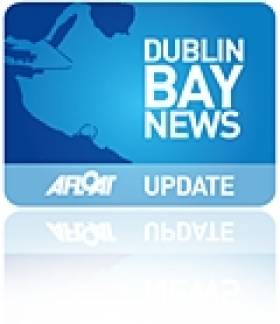Displaying items by tag: Square Sail
#BottomsUp - In a follow-up to Square Sail, the film production operator of Phoenix that called to Dun Laoghaire for repairs was made all the more intriguing given as to where the brig berthed, writes Jehan Ashmore.
The 34m long two-masted Phoenix which has made numerous film and TV screen credits, among them as a privateer in the TV series ‘Frenchman’s Creek’ set in Cornwall is also where Square Sail are based. The call to Dun Laoghaire of the almost 80 gross tonnage brig led to a berth most unusally located in the harbour's innermost Old Harbour.
The particular berth in front of the Irish National Sailing School (INSS) was almost tucked into the corner of where the harbourside road leads up to the foot of the West Pier. As for the reason of the call to the INSS as previously reported on Afloat was because the Phoenix required repairs to the hull's ‘bottom’ timbers.
Previously, Phoenix participated at the Dublin Riverfest on the Liffey last weekend. The work at neighbouring Dun Laoghaire was chosen because of the tides that allowed the brig drawing 2.6m to settle on the muddy bottom within the harbour. Such an exercise could not have taken place on the Liffey nor at the capital's last dry-dock having recently closed.
This alternative 'open' dry-docking involved the hull of the Phoenix to lean against the quay wall of the West Pier. As pictured above at low tide is a boat and personnal alongside the bottom timbers.
The 1929 Danish built schooner now brig has a rig based from the period 1760. The year is somewhat apt as the Old Harbour’s Pier was constructed in 1767. Those in the clubhouse of the nearby Dun Laoghaire Motor Yacht Club (DMYC) have elavated views across this harbour to the pier that this year celebrates its 250th anniversary.
Well that’s something new to learn of and all thanks to the Dun Laoghaire Harbour Company’s Walks Map, for a PDF download click here. So do get out and enjoy celebrating the magnificence of the harbour both old and the new!... in this Bicentenary year.
For those taking a stroll along the West Pier, driving past on related road and of the DART line parallel, the sight of a tallship Phoenix was no doubt a surprise to many.
Otherwise the scene here is normally of yachts belonging to the DMYC and a plethora of small sailing craft rafted together from the INSS. As previously reported the INSS had a relationship 20 years ago with Square Sail during the making of D–Day beach scenes for the film 'Saving Private Ryan' at Curracloe Beach, Wexford.
The last relatively large vessel in the Old Harbour based from personal recollection was an abandoned trawler that had lain for years. The trawler was at the far corner next to the public slipway. Adjoining this amenity is now an area for car-parking that encroached into the harbour, however it is useful for small leisure craft activity.
Work to repair Phoenix was completed yesterday and with that the tallship departed last night. This involved passing the outer Coal Harbour with its Traders Wharf. At the end of this pier is the popular Fish Shop along with eager seals always on the look out for a free meal!
Beyond the shop within the former BIM ice-plant facility are the marina breakwaters that lead out into the open expanse of the harbour. Having passed the commanding yet graceful West and East pierheads the brig headed into Dublin Bay to anchor last night.
Twelve hours later Phoenix and her crew set off this morning bound for Drogheda.
The Co Louth port is to welcome tommorrow morning Phoenix as part of 'Parade of Sail' when heading up the Boyne. This in advance of the weekend’s wonderful gathering of tallships at the Irish Maritime Festival, for much more click here.
Film To Seek "Treasure Island" in Dublin Bay
The 145-foot Earl of Pembroke, a three-masted barque will be centre-stage. Shooting is expected to start in early November for the made for TV movie which is to be broadcast in two parts.
Dun Laoghaire's strategic location on Dublin Bay with close proximity of Dalkey Island, Killiney Bay and Wicklow Mountains to the south coupled with the backdrop of Howth Peninsula, will provide plenty of scope for cinema-photography.
With the Earl of Pembroke to be based in Dun Laoghaire, the harbour town is also home to the film's production company Parallel Film Productions which has included works such as Amongst Women, Breakast on Pluto and the TV series, The Clinic for RTE. In addition the locally based Irish National Sailing School (INSS) on the West Pier, aside from operating sailing activities, have also built up a strong reputation in marine-support and equipment services for film, TV and advertising. Projects have included the films, Saving Private Ryan, Into The West and TV series The Tudors.
The 350-tonnes, Earl of Pembroke is by no means just a floating prop. Launched as Orion, the vessel was built at Pukvik, Sweden in 1948 and for nearly three decades she sailed the North Sea on the timber trade from the Baltic Sea to British ports until laid-up in Denmark in 1974.
The vessel lanquished for several years but in 1979, Cornwall based Square Sail purchased her. In 1985 the vessel underwent a complete restoration programme and in 1994 the vessel re-emerged as a 18th century barque. Among the many film roles, she became the HMS Hotspur in the TV series 'Hornblower'. This year the vessel was involved in a major pirate themed mini-series for French TV which was shot in Corsica. Square Sail's specialisation in providing 'tall-ships' for the film industry also includes the vessels, Keskalot and Pheonix.






























































